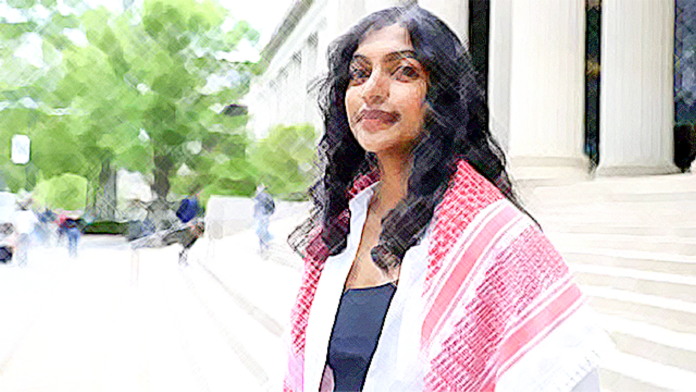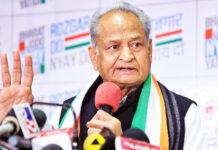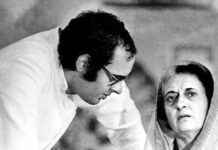‘Deracination’ occurs when a student’s rich heritage is reduced solely to negative analytic lenses like caste and patriarchy, severing emotional bonds to tradition and ancestors.
MUMBAI: The images have been hard to ignore: tent encampments on prestigious American university lawns, fiery speeches echoing through historic quads, and among the diverse crowd of protesters, a noticeable presence of students of Indian origin. Their impassioned advocacy for the Palestinian cause, culminating in arrests, suspensions, and even visa revocations, has garnered headlines globally. On the surface, this might appear as a commendable display of universal conscience – young minds standing up against perceived injustice. However, a closer examination, particularly through the lens of how Western academia treats Indic civilizational narratives, reveals a troubling double standard, a form of selective idealism that exposes not just the students’ priorities, but the pervasive biases of the very institutions shaping their worldview.
Let’s be clear: the issue is not the act of protest itself, nor is it about denying the complexities of the Israeli-Palestinian conflict. The issue is the striking contrast between the fervent, often self-sacrificial, commitment shown towards one cause, and the deafening silence, or even complicity, regarding the systemic marginalization and distortion of their own civilizational heritage within the same academic environment. This isn’t sympathy for these students; it’s an analysis of their performative idealism, which appears deeply influenced by academic frameworks that elevate certain narratives while actively suppressing others, particularly those pertaining to Indic experiences and concerns.
As a framework for understanding this phenomenon suggests, Western academia often operates under an “Epistemic Hegemony.” This isn’t just about what is taught, but “how” it is taught. Theoretical monocultures, such as rigid applications of Critical Race Theory or postcolonial frameworks, often reduce complex Indic realities to simplistic “oppressor/oppressed” binaries. Caste is framed solely as a static, oppressive hierarchy, ignoring its historical fluidity and the internal reform movements within Hinduism. Hinduism itself is frequently pathologized, stripped of its philosophical depth and reduced to social ills.
Crucially, this hegemony manifests in “Silenced Histories.” While the suffering of certain groups is amplified and centered in curricula and campus discourse, the historical traumas and ongoing challenges faced by Indic communities are routinely erased or downplayed. The brutal violence of the Partition of India, one of the largest forced migrations and humanitarian crises of the 20th century, is often glossed over or presented in a sanitized manner that fails to capture the scale of Hindu and Sikh suffering. The targeted ethnic cleansing of Kashmiri Pandits in the 1990s, a clear case of civilizational victimhood, receives scant attention compared to other ethno-religious conflicts.
Consider the examples provided: Megha Vemuri, the MIT Class President, using her commencement speech to condemn MIT’s ties to Israel and label actions in Gaza as “genocide,” leading to her being barred from graduation. Ranjani Srinivasan at Columbia, facing visa revocation for her activism. Achinthya Sivalingam arrested at Princeton. Prahlad Iyengar suspended from MIT for his pro-Palestinian writings and organizing. These students demonstrate a willingness to risk significant personal and academic consequences for a cause they champion.
Yet, where is this same level of outrage and activism regarding the systematic whitewashing of Mughal atrocities in history departments? Where are the protests against scholars who receive prestigious platforms despite downplaying centuries of temple destruction, forced conversions, and massacres? The framework highlights “Institutional Bias” through “Citation Asymmetry,” where scholars who present a sanitized view of invaders or frame Indic resistance negatively are cited and promoted, while those who document civilizational trauma are marginalized or attacked. Audrey Truschke’s work on Aurangzeb, which has faced significant criticism from historians for downplaying his religious persecution, is often platformed, while critical voices are dismissed.
This leads to the second mechanism of erosion: “Social Enforcement.” Western academic spaces often create an “Activism Economy” where social capital and moral standing are tied to endorsing a specific set of “approved causes.” Pro-Palestinian activism, framed within the dominant postcolonial narrative of the oppressed colonized versus the oppressor colonizer, fits neatly into this matrix. Conversely, advocating for Hindu concerns, highlighting Hindu victimhood, or defending Indic civilization against academic or media attacks is often met with “Moral Stigmatization.” The term “Hindutva” is deployed as a pejorative to instantly delegitimize any articulation of Hindu identity politics or defence, regardless of the nuance.
This environment fosters “Self-Censorship.” Students quickly learn that expressing solidarity with Palestinian rights is rewarded with peer approval and academic validation, while raising issues like anti-Hindu hate crimes, the plight of minorities in neighboring countries, or the historical persecution of Hindus is likely to result in being labeled as “nationalist,” “communal,” or even “supremacist.” The framework points out how advocacy for Hindu concerns is often dismissed as “Hindu victimhood” and equated with “nationalist propaganda,” effectively silencing legitimate grievances.
The psychological and cultural effects of this systemic marginalization are profound and contribute directly to the selective activism we observe. “Deracination” occurs when a student’s rich heritage is reduced solely to negative analytic lenses like caste and patriarchy, severing emotional bonds to tradition and ancestors. “Ancestral Alienation” sets in when students are taught to view their ancestors not as legacy-bearers who built a civilization, but primarily as “oppressors,” particularly through the distorted framing of complex historical events like temple destruction as mere “religious contestation” rather than acts of civilizational subjugation.
This leads to “Moral Equivalence,” where the actions of a democratic state defending itself against terrorism (like India’s counterterrorism efforts or actions in Kashmir) are conflated with the actions of non-state terrorist groups (like LeT or Hamas). This obscures the imperatives of civilizational defence and makes it morally permissible, even desirable, for students to critique their own nation while aligning with narratives that are often hostile to India’s interests and historical truth.
The Indian-origin students protesting in the US are operating within this biased ecosystem. Their activism, while framed as universal justice, appears to be a product of this specific academic conditioning. They are vocal proponents of causes that are amplified and validated by their institutions and peer groups, causes that earn them moral currency in that specific environment. Yet, they remain conspicuously silent on the systematic academic assault on their own heritage, the erasure of their ancestors’ suffering, and the delegitimization of their civilizational concerns.
Where were the encampments demanding accurate representation of Partition horrors? Where are the sit-ins protesting the academic downplaying of the Kashmiri Pandit exodus? Where is the outrage against scholars who receive tenure and grants for promoting narratives that paint Hindu civilization in the darkest possible light while ignoring its resilience and contributions? The examples provided—Vemuri, Srinivasan, Sivalingam, Iyengar—show students willing to face severe consequences for Palestine. This level of commitment is absent when it comes to defending their own historical truth or advocating for Indic issues that are actively suppressed in the same universities.
This selective outrage is not just hypocritical; it’s a symptom of a deeper problem. It reflects a form of identity fragmentation where aspects of the students’ identity (their “Indian-ness” or Hindu heritage) are either suppressed or viewed through a negative, externally imposed lens, while a performative global identity aligned with fashionable causes is embraced. They have internalized the academic framework that deems certain victimhood narratives worthy of fervent advocacy, while others, particularly Indic ones, are either dismissed or framed in a way that makes solidarity impossible or undesirable.
This phenomenon should serve as a wake-up call for India. It highlights the effectiveness of Western academic and institutional mechanisms in shaping the narratives and priorities of some sections of the Indian diaspora youth. These students, often seen as future leaders, are being moulded in environments that are, according to the framework, systematically hostile to Indic civilizational interests. Their selective activism contributes to the global perception of India and Hinduism through a distorted lens.
It is time for introspection, not just among these students, but within the broader Indian discourse. We must understand the mechanisms by which our narratives are being eroded and our youth are being deracinated in foreign lands. The performative idealism witnessed on US campuses, while seemingly noble, is a stark reminder of the urgent need to challenge the academic frameworks that create such double standards and to empower the next generation with a robust, accurate, and unapologetic understanding of their own civilizational legacy. Their silence on their own history, contrasted with their loud protests for others, is the most compelling argument against their selective idealism.
* Brijesh Singh is a senior IPS officer and an author (@brijeshbsingh on X). His latest book on ancient India, “The Cloud Chariot” (Penguin) is out on stands. Views are personal.








